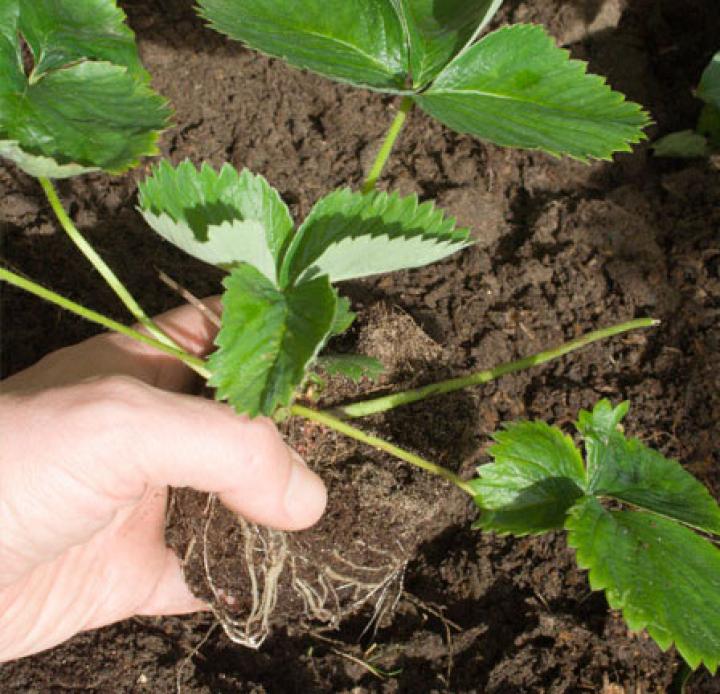Get More Strawberries for Free!
Never waste money buying lots and lots of strawberry plants. Take advantage of a quirk of nature as you turn one strawberry plant into hundreds. Yup, all you need is one plant! See three ways to grow more strawberries—for free.
3 Ways to Grow New Strawberry Plants
There are three different ways to propagate or produce new strawberry plants: seed, division, and runners.
1. Grow Strawberries From Seed
The first way to grow more strawberries is by using their seeds. They form right here on the outside of the berry. Saving your own seeds and growing them is quite a fun way to grow but it takes a lot longer and, with most strawberries being modern hybrids, there’s a high risk that the seedlings you get from seed you collect yourself won’t be anything like the parent plant.
So if you’d like to try growing strawberries from seed, it’s best to look for seed packets that you know will come true to type. If you haven’t got any strawberries to begin with and want to get lots of plants all at once and on the cheap, this could be the way to go.
- Sow seeds into moist potting mix. Just scatter the seeds over the surface before very lightly covering with a little more of the mix. Cover with clear plastic then germinate in a warm place; a cool room temperature would be fine.
- If you’re going the seed route, the best time to sow is in the spring. Once the seedlings are up, grow them on in a bright position but out of direct sunshine. Then once they are about 3 inches (8 cm) tall, transfer them to their own pots. Grow on then gradually acclimatize to the outdoors before setting them out about a foot (30 cm) apart. They can also go into containers at a closer spacing.
- As well as growing regular strawberry varieties from seed, growing from seed is the best way to grow more alpine strawberries – the tiny sweet strawberries that naturally self-sow.
2. Growing Strawberries by Division
You can take a single strawberry plant and divide it. The crown of the plant right at the center can split, producing two plants, which can then be carefully eased apart to replant. (See video for demo).
But division is a risky business, often damaging one or both of the divisions. It also makes little sense to dig up and split plants when they’re so easy to propagate from their runners. So let’s move swiftly on to the third, best and easiest way to grow more strawberries: runners.
3. Runners on Strawberry Plants
If you’re growing your own strawberries you’ll probably be familiar with these long, wiry stems racing out from your plants. They’re called ‘runners’ and are perhaps the most efficient way that strawberries reproduce themselves. We can use this naturally occurring habit to grow replacement plants – or to expand strawberry growing areas to other parts of the garden.
Botanically speaking, what we’re seeing here are stolons – creeping horizontal stems that produce roots at intervals along their length, where these little clusters of leaves are, to form new plants. Look closely at the plantlet at the end of the runner to see tiny roots already beginning to form. This can be rooted and grown on to produce new plants.
Growing new plants from runners is pretty much bulletproof – it’s hard to go wrong. And when you grow new strawberries this way you’ll get identical plants, because they share the same genetics.
- Only propagate using healthy plants, so you’re not passing on any diseases or viruses to the new plants.
- Runners are best taken from plants that are at least one year old.
- Remove runners coming from younger plants as they take a lot of the plant’s energy to produce and you want the plant to concentrate on establishing itself first. Cut off from where they emerge to concentrate the plant’s efforts on fruit production.
- Unless you plan to dispose of the parent plants, limit the number of runners to five per plant.
How to root runners in pots
If you want to simply bulk out an existing strawberry bed, you’ll just peg down the runner right in the soil where they are—with a hairpin, U-shaped clip or a length of garden wire bent into shape. You can direct the runner to where you want it – they’re nice and flexible like that.
But if you want to transplant your runners elsewhere, then root your runners into pots. You’ll detach them from the mother plant. (Note: It really helps to watch the video for this section unless you’re familiar with how to plant runners.)
- Prepare your pots. Fill them with an all-purpose/multipurpose potting mix, firm down then water to thoroughly wet the mix.
- To secure our runners onto the pots: Wherever you see a small cluster of leaves, no matter how small, is where the runner wants to send out new roots. You may see the very beginnings of roots, you may not – but this is what we want to pin down into our pots.
- To pin them down, you can use a small rock or a hairpin, for example. Another option is to make your own staples using thick-gauge wire or perhaps lengths cut from an old wire coat hanger. But you could use anything to make your staples, even a wooden skewer.
- Each cluster of leaves, or node, is pinned down with the staples. Hold the leaves so they’re pointing up and make sure the base of the node is pushed down onto the potting mix. Push in the staple to hold it in place. We want to make absolutely sure the bottom is in really good contact with the potting mix, so it knows to start pushing out those roots.
- If the runner has already rooted into the soil, no problem – just carefully dig it up with a hand fork and then repot into your prepared pot.
Older, longer runners may have more than one node along their length, and you can use each of these to create a new plant. If you have lots of runners, though, limit things to one node per runner, pinning down the one closest to the mother plant and cutting off the growth beyond where you’ve pinned it down to concentrate all of the energy from that runner into producing just one strong plant.
In general, if you’re not propagating any more strawberries, it’s best to remove any runners that are formed, to keep the energy within the plant so it has more oomph behind it to produce plenty of flowers and, of course, berries. If you don’t cut back your runners, you’ll end up seeing way more leaves than fruit! Just reach down and clip off the runners. We do this around the time when school’s go back but any time between spring and fall is okay as long as the runners have produced adequate root growth.
Cutting off the New Plant
Think of runners as an umbilical cord. It’s the lifeline of the new plant, and you want to leave it attached to the mother plant for as long as possible.
- Keep the pinned-down runners from drying out. Water regularly, as much as once or twice a day in very hot, sunny conditions.
- Only cut off the new plant from the mother plant once it has properly rooted into the potting mix.
- After about 4 to 6 weeks, a small strawberry plantlet will have started to grow new leaves, so it’s time to cut it free from the parent plant. Detach it too early and the young plant may not be able to fend for itself and could simply shrivel up.
- It’s good to see the roots at the edge of the pot before planting t it elsewhere. Choose a sunny position in well-drained, fertile soil for your new plants, or plant into suitable containers. Continue to water then begin feeding with a liquid tomato feed when they start to flower, usually next spring.
- Alternatively, overwinter your strawberries in a greenhouse or cold frame if it’s nearing winter, then plant out next spring, which is particularly useful if winters are harsh in your area.

How Often to Cut Runners
Strawberries become less productive over time, so you need to grow more plants from runners every 3 to 4 years to ensure continuing good harvests. For best results, grow each new generation of strawberries in a completely fresh bed enriched with compost to avoid the build up of disease. You could also use your new plants to fill a special strawberry planter, troughs, or perhaps a handsome terracotta pot.
If you love getting something for free, then propagating new strawberry plants from runners is well worthwhile! By using the runners produced by existing plants to grow new plants, you’ll be able to keep your strawberries going on and on, season after season, far into the future. Sweet, juicy strawberries… for free… for life!
For more information about planting, growing, and harvesting strawberry plants, see the complete Strawberry Gardening Guide or our article on Growing Strawberries in Containers.
More Like This
Hi Jennaay, Thanks for the question. You can bring your strawberry runners indoors to plant and begin the growing process, but it is best to plant your runners within a day or so of harvesting. This article provides the steps you need to take for planting them. You will want to keep your planted runners in a sunny, humid location and provide frequent misting. Once your runners have rooted, that is the time to fertilize biweekly. Over the winter months, the runners will grow into plantable strawberry plants that can then be placed in the garden or repotted in the spring. Happy growing!
Yes, strawberries can be brought inside for winter, but rather than properly indoors, in the house, it would be better to move them into, say, an unheated garage or other outbuilding. That is because strawberries need a period of chilling - they need some cold - in order to encourage them to produce flowers and fruits the following season. Without this they won’t do that.
Or, if you are just wondering how to protect them from cold, the answer would be that you can protect them from the worst of the deep cold by just covering them straw or similar to insulate them, or moving them closer to the house, into a greenhouse or garage etc. But not into a heated place where they won’t get that chilling period.
- « Previous
- 1
- 2
- …
- 10
- Next »









